When we talk about building businesses, we often talk about how data is a compass, guiding organizations toward more informed and strategic decision-making, which is obviously important for growth. CRM data is a huge part of the current and ongoing data revolution, providing a whole host of insights that businesses can leverage to refine their strategies, enhance customer experiences, and ultimately drive that much-needed growth.
Businesses like yours can unlock all sorts of opportunities by understanding and utilizing the data generated through CRM systems, leading to more effective decision-making. Let’s move on and talk about a few of the ways you can use said data.

First off, CRMs are a huge part of transforming sales strategies, bringing data-driven precision to a process that was once more guesswork than anything else. These platforms offer a centralized repository of information where every interaction with a customer or potential lead is recorded and sorted for you to find easily.
By analyzing this data, your sales team can identify patterns, understand customer preferences, and predict future behaviors based on previous actions and responses. For instance, insights gained from CRM data can let the team know which products or product features are working for your customers, allowing sales teams to tailor future pitches accordingly.
Sales forecasting in and of itself also becomes more accurate when grounded in the historical data and trends embedded within CRM analytics. This lets businesses allocate resources more efficiently and set realistic sales targets.

Beyond boosting sales, CRMs also play a key role in improving customer retention. Retaining existing customers is, generally, far more cost-effective than acquiring new ones, so customer retention strategies are a big part of any business’s success.
CRM data provides a detailed view of customer interactions, purchase history, and preferences, enabling businesses to personalize engagement and strengthen sales and retention relationships. By segmenting customers based on their behavior and preferences, a business can develop far more targeted communication strategies that actually resonate with their clients on a far more personal level. This targeted approach fosters loyalty and encourages repeat business, creating a mutually beneficial relationship between customer and company.
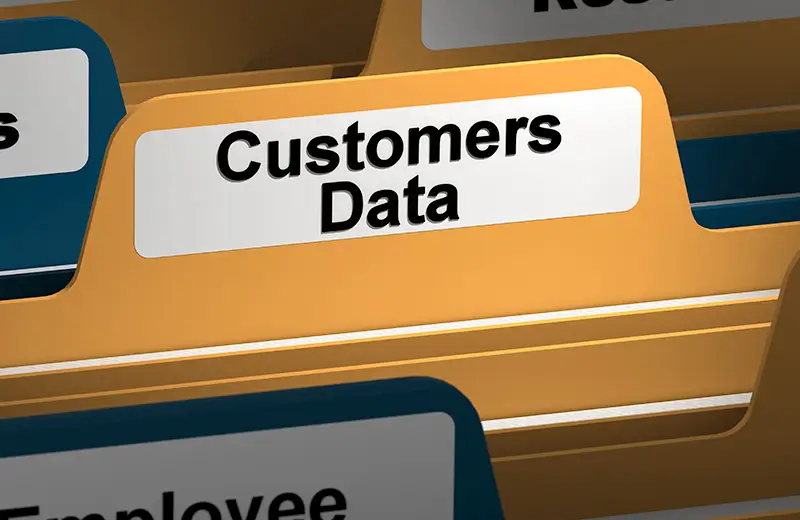
Another benefit is how integrating CRM data into the decision-making process can elevate a company’s competitive edge. Businesses that effectively harness their CRM data are better positioned to understand real-time market trends, anticipate customer needs, and more quickly adapt to changes.
By having access to real-time data, decision-makers can quickly assess the impact of their strategies and make timely adjustments, rather than waiting weeks or even months to see results. This agility is invaluable when we are talking about a market where consumer expectations and competitive dynamics are constantly shifting and changing.

Now, while the benefits of leveraging CRM data is pretty clear, many businesses might face challenges when it comes to effectively utilizing said information. Data silos, inadequate data quality and storage, irrelevant data, and lack of proper training or tools can hinder the full potential of any system and any team.
To maximize the value of CRM data, you should prioritize data cleanliness and invest in platforms that facilitate seamless data integration and analysis. Furthermore, equipping your team members with all the necessary skills to interpret and act on data insights is equally important to foster a data-driven culture within the organization.

Ultimately, CRMs serve as a fundamental tool for any business that wants to boost its decision-making processes. By tapping into the rich datasets offered by these systems, companies can refine sales strategies, bolster customer retention, and make even more informed decisions.
However, the key to this success lies in overcoming data-related challenges and encouraging a culture that values said data-driven insights. So, to stay ahead of the curve and make informed decisions, you need to make data your friend, and you can only do that by utilizing your CRM to its fullest and getting your entire team to do the same.
For extra insights on how to make the most of your CRM, check out these blogs:
Ready to make smarter, data-driven decisions? Book a free consultation today to learn how CRM data can transform your business strategies and help you achieve your goals!
When it comes to our increasingly digitally connected world, communication platforms such as Zoho Cliq and Slack have become absolutely indispensable tools for any business that wants to improve teamwork and streamline workflows. Both platforms offer a suite of features, each designed to foster collaboration, but they are unique in their approaches and offerings. Let’s take a look at each platform so you can better decide which suits your business needs the best.

Zoho Cliq is a business messaging tool that is part of the broader Zoho family of apps and can integrate seamlessly with other Zoho services. One of Cliq's most notable advantages is its operation within that larger ecosystem, making it a great choice for businesses already using other Zoho apps.
Other benefits include a fairly intuitive user interface emphasizing organized conversations that are easy to reach, scroll through, and manage. Features such as searchable archives, customizable modules, and pretty robust security measures mean that teams can easily communicate confidently. Customization is another area where Zoho Cliq shines. It allows businesses to create custom bots and commands, giving users more control over how they interact with the platform.
In terms of pricing, Zoho Cliq is also more budget-friendly. It offers a free plan with unlimited messages, search history, and file sharing, compared to Slack’s more restricted free tier. Paid plans for Cliq are also typically lower than Slack’s, making it a cost-effective solution for startups and small-to-medium businesses.
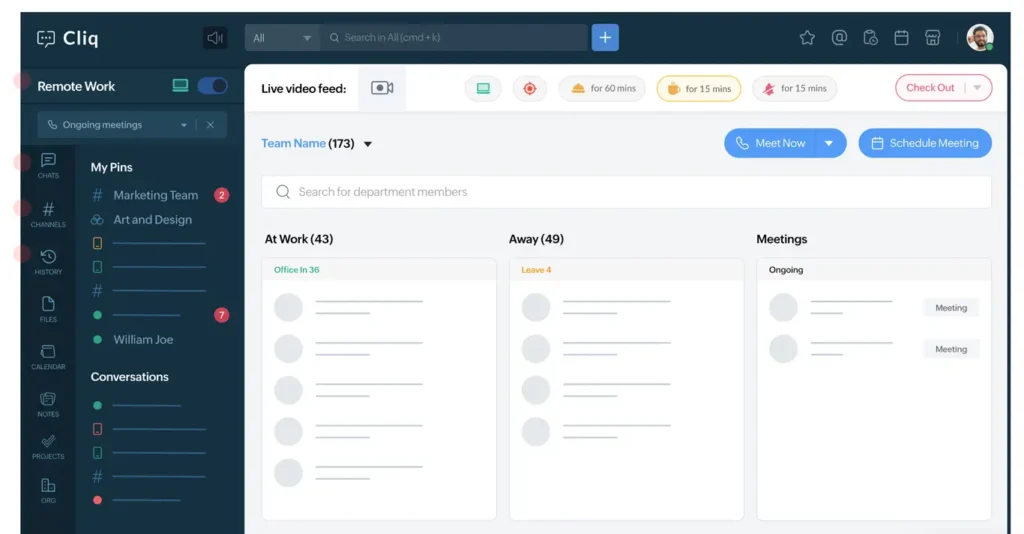
On the other hand, Slack has gained popularity, especially during and directly after the pandemic, and has established itself as a household name in team communication. Most of Slack's appeal lies in its versatility and adaptability. It offers a broad range of integrations with third-party applications, including Google Workspace, Microsoft Office 365, and more. However, it lacks the native integrations that Cliq boasts.
Slack’s user-friendly interface is versatile enough to accommodate both small teams and large enterprises with channels, direct messages, and threads allowing for dynamic and scalable conversations.
While Slack offers a wide range of features and app integrations, it comes at a higher price point, particularly for teams needing unlimited message history or advanced security features. This has led many businesses to consider alternatives like Zoho Cliq, which offers similar functionality at a lower cost, making it an attractive option for budget-conscious teams.
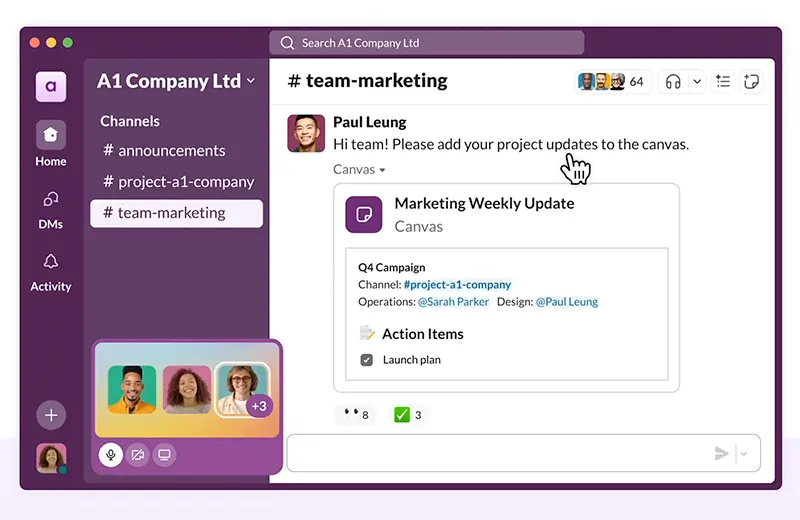
While Zoho Cliq benefits from an integrated ecosystem when paired with Zoho apps, many focused on business growth and communication, Slack stands its ground with a larger pool of outsider integration capabilities to over 2,000 apps. If your organization needs extensive customization and is willing to pay for it, Slack’s API and developer tools might be better for you as they offer more tailored solutions.
While both platforms prioritize an intuitive and seamless user experience, Slack has a slightly more polished design and flexibility that can be more appealing to those companies that want more ‘aesthetics’ in their communications. On the other hand, Zoho Cliq offers a far more organized view and focuses on simplifying navigation for those who prioritize functionality over form.
Zoho Cliq is by far the leader of the two with its competitive pricing, which is especially advantageous for organizations already invested in Zoho products. You’ll save money on Cliq and the Zoho environment in general, which means more cost savings the more you bundle. Slack, meanwhile, offers a free tier with limited features, but its more comprehensive plans come at a premium.
Security is key no matter what communication platform we are talking about. Cliq boasts a number of features and practices to secure user data, from end-to-end encryption, access control, compliance certifications, audit logs, and more. Slack also uses encryptions and data loss prevention methods but has multiple weaknesses, mainly through its integration with outside apps.

Choosing between Zoho Cliq and Slack really depends on each business’s specific needs. For those already embedded in the Zoho ecosystem and looking for cost-effective, seamless integration, Zoho Cliq is the way to go. Its ability to synchronize efficiently with other Zoho apps can streamline processes, minimize redundancy, and enhance productivity. However, Slack may be the better choice if your organization requires a platform with extensive third-party integrations and prioritizes a flexible, customizable user experience.
Ultimately, both Zoho Cliq and Slack are good team communication platforms, and your decision should align with strategic business goals, resources, and existing technology infrastructure. Whichever path you choose, adopting an effective communication tool is an important step toward fostering collaboration and driving organizational success.
Ready to optimize your team’s communication? Book a free consultation with us today!
Many businesses nowadays are turning to digital marketing as a way to stand out in a crowd. Those same businesses are also evaluating SEO vs. PPC to determine which strategies will yield the most effective results. They want to get the most ‘bang for their buck’, which means picking the best strategy for them.
There are two predominant approaches to marketing: Search Engine Optimization (SEO) and Pay-Per-Click (PPC) advertising. Each strategy has its own pros and cons, meaning choosing the right strategy for your business depends on individual factors, including business goals, budgets, and industry dynamics.

First, SEO is the practice of optimizing your website to increase its visibility in organic search engine results. This is done by improving website elements such as content, including blogs and on-site copy, meta tags, headers, and building backlinks that align with search engine algorithms. This method is often seen as a long-term strategy that builds credibility and trust over time, improving overall search results.
PPC, on the other hand, uses paid advertisements to appear higher in search engine result pages (SERPs). Advertisers bid on keywords, and each time their ad is clicked, they pay a fee. This form of advertising is instant and versatile, allowing businesses to reach audiences quickly and effectively. However, once you stop paying for clicks, traffic can drop dramatically, meaning it isn’t a solution that is as long-term as SEO.


Want to learn why SEO is crucial for small businesses? Check out our recent blog.

When it comes right down to it, choosing between SEO and PPC really depends on your business and what you need in both the short and long term. If you want immediate visibility and can afford ongoing advertising, PPC can be a powerful strategic tool. It is also especially helpful for new product launches or targeting specific demographics quickly.
On the other hand, if you want a more long-term online presence and have the time and energy to dedicate to growth, then SEO can be equally advantageous. It creates a foundation of organic, ongoing traffic that can build on itself without constant and active oversight.
For many businesses, the right approach might not be solely SEO or PPC but rather a hybrid approach. Balancing long-term growth with immediate impact will create a comprehensive digital marketing strategy that adapts to different goals and market conditions, benefiting the business in the long run.
Ultimately it is by aligning these strategies with your unique business objectives that is going to be what guides your path towards digital success.
We offer SEO services in collaboration with our partners at Lucent Creative, a female-led digital marketing agency. Need a hand getting your business on the (local) map? Book a free consultation.
When we talk about the must-haves of business nowadays, automating sales processes is going to rank pretty high on any list. There are countless tools and CRM systems right at your fingertips, and they can do everything from simplifying your sales journey to boosting productivity, allowing you to work smarter (not harder) than ever before.
But first, you have to understand how you can automate sales processes in a way that genuinely makes a difference.

When talking about automating your sales process, it is important to choose the right CRM. Some CRMs like Salesforce, HubSpot, and Zoho offer various features to automate different aspects of sales. So, when selecting your CRM, you need to weigh factors like ease of integration with existing sales tools, customization capabilities, and the analytics provided.
Other tools that you can include are systems such as Mailchimp for email marketing, LinkedIn Sales Navigator for prospecting, and Zapier if you want to integrate multiple applications. It might take you a bit, but the right blend of tools will help your sales team reduce their manual efforts and focus on more strategic and necessary tasks.

Now, let’s talk about automating lead management as part of automating sales processes. The first stage of any good sales funnel is capturing and nurturing leads, but that takes up quite a bit of time and effort. Automation tools can streamline lead generation through forms on your website, social media platforms, and targeted ads on various platforms. Plus, implementing automating lead scoring systems can help prioritize prospects, making sure your sales team knows which leads are more promising and should be engaged with first.
Moreover, automating follow-ups via personalized email campaigns is a great way to keep up engagement with those same potential customers. Tools like Mailchimp and ActiveCampaign allow businesses to design tailored strategies for specific audience segments, meaning businesses can nurture leads directly through relevant content that gradually guides them down the sales funnel.

Timely and consistent communication is key to closing sales. Automated responses can acknowledge inquiries or pre-qualify leads, ensuring that prospects feel attended to, even when your team is unavailable. Scheduled emails, chatbots, and social media automation can sustain dialogue with prospects and customers alike.
For instance, utilizing chatbots on your website can provide immediate assistance and gather customer information, freeing up your sales team for more complex interactions. Similarly, a well-structured email sequence can move leads through the funnel, sharing valuable content at critical touchpoints.

As a business owner you already likely know just how much of your sales team’s time is taken up with administrative tasks. Automating data entry and reporting not only saves them time, letting them focus on other aspects of business and bringing in more sales, but it also makes data more accurate.
One example of this is syncing CRM systems with other business applications, which in turn automatically logs interactions and updates client profiles so your team always has the latest info. Additionally, automated reports and dashboards can provide real-time insights into your sales pipeline’s performance. These analytics empower your sales team to make more data-driven decisions, adjust strategies even on the fly, and forecast future sales trends much more accurately.
The final step in automating sales processes is to continually analyze, optimize, and improve. Metrics such as conversion rates and deal velocity should be regularly reviewed to ensure that the approach aligns with business goals and market dynamics.
To make sure that you are optimizing and improving properly, make sure you are getting feedback from your team so you can identify and rectify bottlenecks or inefficiencies. Also, remember to remain open to incorporating new tools or strategies to further enhance performance.

In the end, by tapping into the power of sales automation tools and CRM features, businesses can not only improve efficiency but also unlock greater growth potential through automating sales processes. This approach can transform how your sales team operates, granting them more time to do what they do best: foster meaningful relationships and drive sales. So, what are you waiting for? Get started today and watch your sales process transform into a well-oiled machine that works for your business, not against it. Want to find out how we can help you? Let’s chat.
If you have ever tried navigating the world of Customer Relationship Management systems, or CRMs, then it might have occasionally felt like sailing through some particularly stormy seas. One moment you are doing fine and the next you are thrown completely off course by the always-changing tides of tech and user demands. Luckily it doesn’t have to stay that way! Today we are highlighting five common CRM mistakes and how you can transform them from pitfalls to valuable insights.
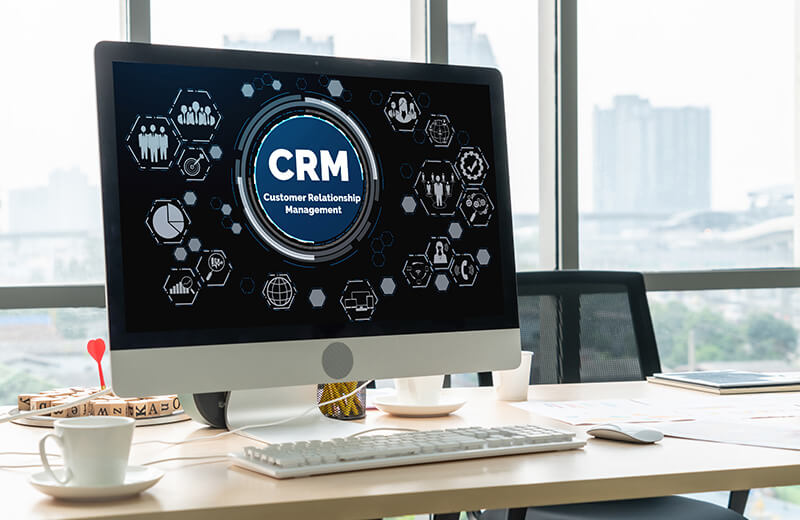
Now, it is tempting to think that your shiny new CRM system is a plug-and-play; you just put in your info and start using it right away. Unfortunately, one of the most common mistakes we see people make is skipping training for your team early on. Any CRM is only as effective as the people using it and if your staff does not know how to navigate its features, especially the ones critical to your business, that system essentially becomes a costly digital paperweight.
Luckily for you the fix for this particular mistake is fairly easy. Invest in a comprehensive training program for all employees who will interact with the CRM software so that everyone knows what they are supposed to be doing. Most CRMs have training sessions specifically to train teams just like yours or you might engage a CRM consulting firm such as ours to get everyone up to speed. And, remember, continuous learning should be trusted and drilled into the company culture, encouraging users to enhance their skills and productivity.

Next up, customizing a CRM can make it feel tailor-made for your business, keeping the most useful aspects and dropping ones you don’t need, but beware the trap of over-tweaking! Too much customization can lead to maintenance nightmares and confusion among users, especially those who have been trained to expect things a certain way.
To solve this problem it is best to adopt a 'less is more' philosophy when it comes to customizing your CRM. Focus on essential modifications that directly enhance business goals. Make decisions by consulting the team that will use or maintain the system, and ensure customizations support business processes rather than slow them down.

Moving on, a CRM system is only a tool and not a genie to make all your problems disappear with the press of a button. And, most importantly, it cannot do anything on its own. Without clear goals and objectives, i.e a proper plan for what you want your CRM to do and how it will benefit your business, you'll find yourself tangled in a mess of features and data with no defined endpoint in sight.
Instead, start off on the right foot by clearly defining the goals you want to achieve. Are you looking to improve customer engagement, streamline sales processes, or better analyze data? With targeted objectives, you can better assess CRM features and align them with specific business needs. Keep in mind that you will need to regularly revisit and refine these goals as your business evolves.

This is a two-fold problem… A CRM system without data being fed into it continuously is a ship without a compass, but one with too much extraneous info is effectively a digital junk drawer. You want to find the right balance between too little and too much data, and poor data management leads to inaccurate client profiles and misguided decisions.
To fix this, implement data quality measures by regularly auditing and cleansing your database. Also, make sure that there are consistent data entry protocols and implement automated processes where possible to avoid human error. Your best bet here is to assign a CRM leader - a dedicated staff member responsible for database accuracy and integrity.

Finally, any CRM system should empower its users at every level, from the very bottom to the tip-top, and not become some stagnant thing that never updates with the change of time and users. Ignoring the valuable feedback of those who interact with the system daily can cause all sorts of problems, from disengagement to inefficiency and more.
Instead, aim to cultivate a consistent feedback loop with CRM users. This can be done by creating forums or channels specifically for CRM discussions. Also, allow and even encourage staff to propose improvements.Continuous feedback, followed by actionable reforms, can unlock the potential of even the most reticent CRM user.

In the end, identifying these common CRM mistakes and applying out strategic solutions instead will allow business leaders to harness the power of their systems far more efficiently and effectively. Let's turn those potential pitfalls into great opportunities for you and your team so that you can get back to the business of doing business.
At Woggle Consulting, we love Zoho CRM for its flexibility and user-friendly features. For more insights on optimizing your CRM experience, check out our blog on how to migrate to Zoho CRM.
Are you trying to find the right app for your recruitment needs? Zoho Recruit and Breezy are two standout recruitment apps in this arena, and both platforms offer some pretty powerful tools to streamline the recruitment process but cater to slightly different aspects of a business's needs. Let’s dive right into what sets them apart and why Zoho Recruit edges out the competition.

First things first, a user-friendly interface that is easy to navigate will make or break the efficiency and speed of your recruitment team. Zoho Recruit stands out here thanks to its clean and intuitive design, allowing users to navigate different modules seamlessly. Users have commented on how they appreciate the fluidity of moving from candidate sourcing to database management without complications, making it easy to flip from candidate to candidate throughout the recruitment process.
Uncover all the essential insights about Zoho Recruit that you need to elevate your recruitment game here.
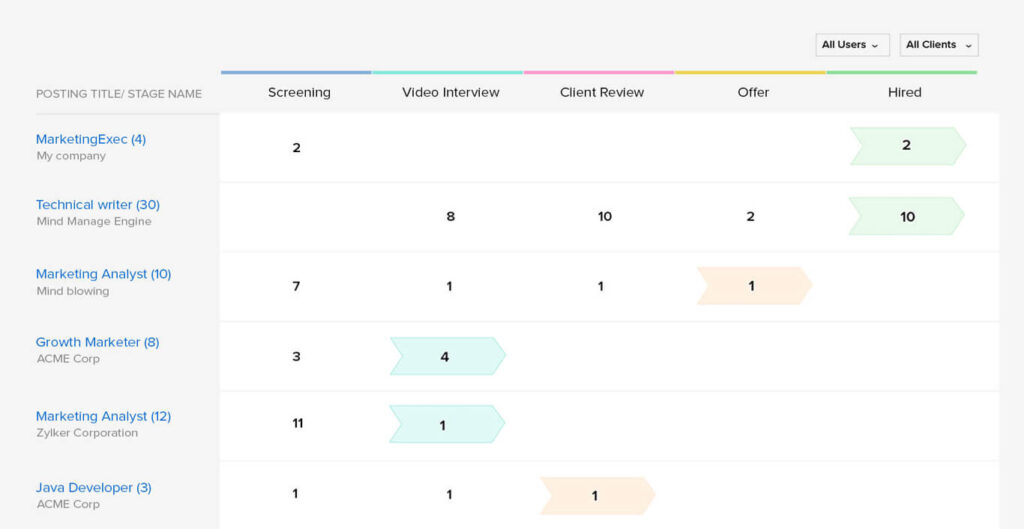
On the other hand, Breezy offers a similarly modern interface, but new users might find it requires a steeper learning curve than Zoho Recruit. Breezy tends to emphasize visual pipelines, which may appeal to teams that prefer a more visual approach, but can get cluttered when solely focusing on managing applicants.
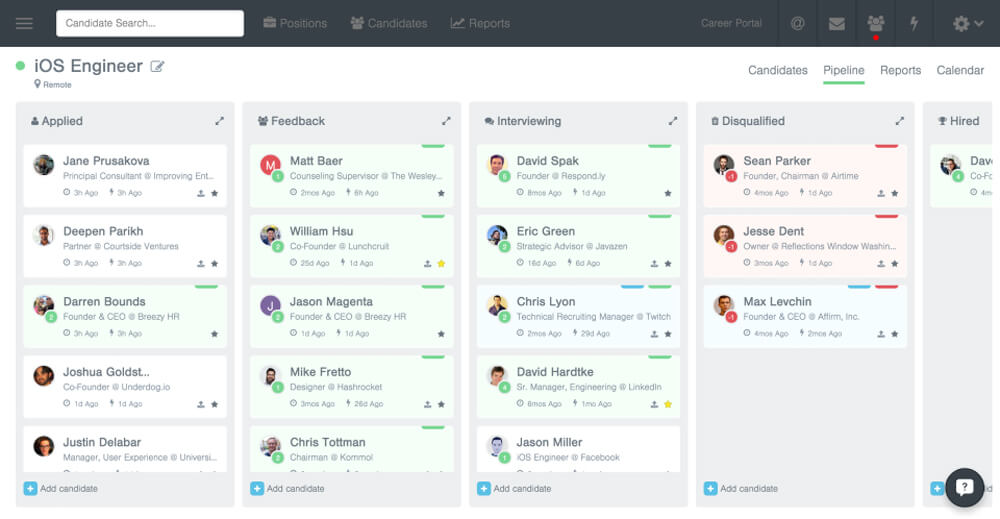
Next, when it comes to features, Zoho Recruit offers a comprehensive suite designed to address all the different nuances of recruitment management, boasting powerful automation tools, customizable workflows, and advanced analytics for better decision-making. Its integration capacity is also fairly robust, catering to a wide spectrum of third-party applications, which makes it easier to use.
Breezy also provides some pretty nice features, such as video interviewing and easy collaboration tools, but tends to focus more on candidate experience rather than administrative efficiency. So, again, while things might look nice, they might not always function the way a business would prefer.

Now, while both platforms offer customization options for large and small businesses, Zoho Recruit shines here thanks to its high level of adaptability. Zoho’s diverse product ecosystem and its ability to integrate with additional functionalities allow it to grow with your business seamlessly.
Breezy, while offering some customization, may not scale as effortlessly as Zoho Recruit, particularly if your business is on the larger side and has more complex hiring strategies. This makes Zoho Recruit a more future-proof investment for businesses aiming for growth and adaptation as their hiring needs change.
One of the major strengths of Zoho Recruit, and one many businesses consider a major win, is its ability to integrate with other Zoho products and many third-party applications, creating a cohesive ecosystem for business operations. This interconnectedness makes sure that data flows smoothly across platforms, reducing redundancy and enhancing efficiency.
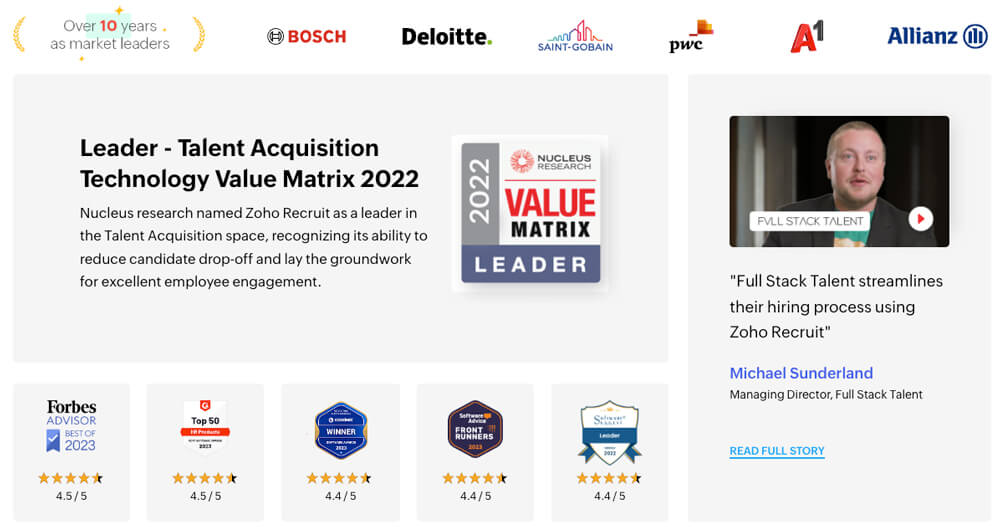
Meanwhile, Breezy offers integrations as well, but the fact of the matter is that its ecosystem is simply not as expansive nor versatile as Zoho's. This means businesses with Breezy will be limited just a bit, especially if they rely on extensive third-party solutions.
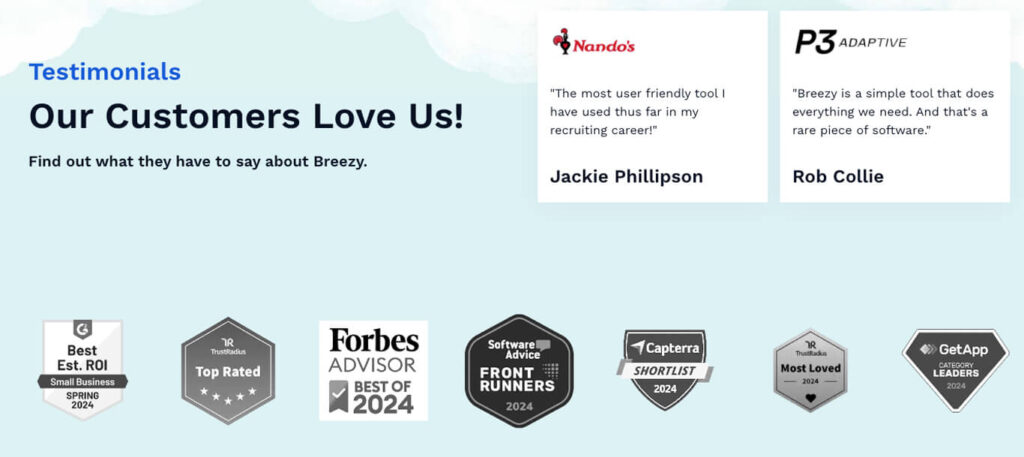
Finally, budget is always a big consideration when it comes to picking any solution. Zoho Recruit is known for its cost-effectiveness, offering various pricing plans that, again, cater to businesses of all sizes. It delivers on the promise of value for your money, especially considering all the wins above.
Breezy, on the other hand, maintains similarly competitive pricing but may escalate costs by adding various needed integrations or add-ons. This could make this app less budget-friendly in the long term.

To wrap things up, both Zoho Recruit and Breezy offer some pretty commendable features that can boost your business’ recruitment process. However, if you’re looking for a solution that supports future growth, offers cost efficiency, and integrates seamlessly with a comprehensive ecosystem, Zoho Recruit will be the clear winner.
Explore the showdown between Zoho Recruit and Manatal to see which recruitment app comes out on top!
If you're running a business and looking to grow your online presence, you've probably heard the term "digital marketing funnel." It might sound like marketing jargon, but a digital marketing funnel is one of the most powerful tools to attract potential customers, guide them through their buying journey, and convert them into loyal clients.
So, what exactly is a digital marketing funnel, and why do you need one? Let’s break it down.

A digital marketing funnel is the path your potential customers follow from the moment they first discover your brand to when they make a purchase (or even beyond). It’s called a “funnel” because, like a real funnel, it narrows down as people move through the stages. At the top, you’ve got a broad audience that may not know anything about your business, and by the time you get to the bottom, you have a smaller, more focused group ready to take action.
The key stages of a digital marketing funnel are:
Let’s dive into each stage and talk about how to guide potential customers through this journey.
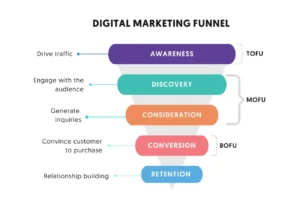
Image credit: reliablesoft
This is the first stage, where people are just becoming aware of your business. They might be facing a problem or have a need, but they don’t know yet that you have the solution. Your goal here is to get your brand in front of as many eyes as possible and make a good first impression.
How to do it:
At this stage, your audience isn’t ready to buy yet—they’re just learning who you are. Your goal is to provide value and catch their attention.

Now that potential customers are aware of your business, they start considering their options. This is where you build trust and show them why you're the best choice to solve their problem or fulfill their need. They might be comparing you to competitors or looking for more information.
How to do it:
This is also a good time to nurture your leads with email marketing campaigns, offering them more value and gently guiding them toward making a decision.
At this point, your leads are ready to make a decision. They’ve learned about your brand, compared their options, and now they’re on the verge of converting into paying customers. This is the most crucial part of the funnel, so your job here is to give them the final nudge.
How to do it:
Your goal here is to make the buying decision as easy as possible and eliminate any doubts they might have.

Congratulations! Your lead has now become a customer. But your job isn’t done yet—this is where the magic of turning a one-time buyer into a loyal customer comes into play. You’ve guided them through the funnel, and now it’s time to deliver a great experience and ensure they’re satisfied with their purchase.
How to do it:
By delivering an exceptional experience after the sale, you increase the chances of your customer returning and recommending your business to others.

Many businesses focus on getting new customers, but don’t forget about the ones you already have! Keeping your customers engaged and coming back for more is a key part of any successful digital marketing funnel. Plus, repeat customers are often more valuable and cheaper to retain than acquiring new ones.
How to do it:
Retention not only leads to more sales but also builds long-term loyalty and can even turn your customers into brand ambassadors.

These days, customers have more options than ever, and they don’t just stumble onto a purchase. They go through a journey—learning about their options, weighing pros and cons, and deciding who to trust. A digital marketing funnel helps you meet your potential customers where they are and gently guide them through each step of the buying process.
By creating a strong funnel, you’re not only increasing your chances of making a sale but also building lasting relationships with your audience. Whether you’re a small business or a growing brand, a well-structured digital marketing funnel is essential to turning visitors into leads and leads into loyal customers.
Our partners at Lucent Creative, a female-led digital marketing agency, help business owners like you set up marketing funnels that convert and boost revenue. Book a free consultation to get started!
If you're a small business owner, attracting local customers is key to growing your business, highlighting the importance of SEO. Whether you're running a café, a boutique, or a service provider, you want the people in your area to find you easily and choose you over the competition. That’s where local SEO (Search Engine Optimization) comes in.
Local SEO helps your business appear in online searches when people are looking for products or services nearby. Think of it as making sure your business pops up when someone searches for something “near me” on Google. Here’s why it’s super important for your business and how you can start using it to get noticed.

The main reason to focus on local SEO is to help your business show up higher in search results when people in your area are looking for what you offer. For example, when someone types in “best pizza near me” or “plumber in [your town],” you want your business to be at the top of the list.
If you aren’t optimizing your website or Google Business Profile, you're missing out on potential customers who are actively searching for services like yours. Local SEO helps you get noticed in these searches, which can land you a spot in the Google Map Pack—that highly visible map and business listing that shows up before any regular search results.
According to Google, 76% of people who search for something nearby on their phone visit a business within a day. That’s a huge opportunity! By optimizing for local SEO, you’re making it easier for people to find your business, see your hours, read your reviews, and get directions—all of which make it more likely they’ll visit you in person.
Local SEO literally puts your business on the map for customers ready to stop by and make a purchase.
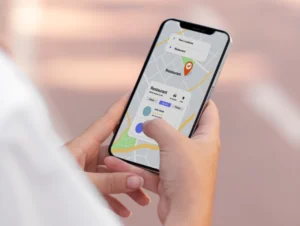
Showing up consistently in local search results does more than increase visibility—it builds trust. When potential customers see your business listed at the top of their search, along with solid reviews, it signals that you’re a credible and trusted option in the area.
Encouraging happy customers to leave positive reviews is a great way to boost your online reputation with the local community. Over time, this can help you stand out as the go-to business in your area.
We know it can feel tough to compete with larger businesses with bigger marketing budgets, but local SEO gives small businesses an edge. While national companies might dominate broad searches, local SEO helps you shine when it comes to location-specific searches.
For example, while you might not beat a big-box store for “buy tools online,” with the right local SEO strategy, your hardware store can easily rank at the top for “hardware store in [your town].” Local SEO helps you go toe-to-toe with bigger brands, especially when it comes to your specific area.

Now that you know how important local SEO is, let’s talk about how to implement it. Here are some simple steps to help your business get found by local customers:
This is the big one! Make sure you claim your Google Business Profile and fill it out completely. Add all the relevant details, like your business name, address, phone number, website, hours, and services. Make sure everything is accurate and consistent across the web.
Positive reviews can give your local SEO a serious boost. Encourage your happy customers to leave glowing reviews on Google, Yelp, and other platforms. The more high-quality reviews you have, the better you’ll rank.

Incorporate location-specific keywords into your website’s content. For example, instead of just saying “best bakery,” try “best bakery in [your town]” to help Google understand where you’re located and match you with nearby searches.
Many local searches happen on phones, so your website needs to work well on mobile. Make sure it loads quickly, is easy to navigate, and has all your key info (like contact details and hours) right up front.

Try adding a blog or news section to your website that focuses on local events, collaborations, or other community-related topics. This will help you rank better in local searches and build a stronger connection with your audience.
Local SEO is a game changer for small businesses. It helps you get noticed by nearby customers, build trust in your community, and even compete with bigger brands. If you haven’t started working on your local SEO yet, now’s the time! With a little effort, you can attract more customers, drive more foot traffic, and grow your business right in your own neighborhood.
We offer SEO services in collaboration with our partners at Lucent Creative, a female-led digital marketing agency. Need a hand getting your business on the (local) map? Book a free consultation.
When you're in the market for a new Applicant Tracking System (ATS), you'll often hear two big names: Zoho Recruit and Greenhouse. Both platforms offer robust features, but deciding which is the right fit for your business can be tricky. Let’s break down how these two solutions compare so you can make an informed choice.

One of the first things you’ll notice about Zoho Recruit is its user-friendly interface. The platform is designed for simplicity, making it easy for even non-technical users to navigate and set up.
Greenhouse has a steeper learning curve. It’s packed with features, but some users find it takes more time to learn and implement effectively.
![]()
Both platforms offer core ATS functionalities like custom career sites, interview scheduling, job postings, and candidate tracking, but they differ in depth.
Zoho Recruit provides a highly customizable platform with features like candidate and vendor portals, multi-org support, and territory management. Its integration with other Zoho apps (like Zoho CRM) also allows businesses to create a seamless recruitment process tied directly to sales, customer management, and more.
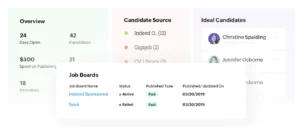
Greenhouse supports a wide range of third-party integrations but lacks most of the customization capabilities that Zoho offers in a side-by-side comparison. For example, Greenhouse does not offer customizable branding or custom functions.
![]()
Both platforms offer a robust hiring pipeline, offer letters and e-signatures, auto-responders, and video interview features. Zoho Recruit includes useful team management features like candidate evaluations and email alerts for interviews. Greenhouse doesn’t pack as hard as a punch when it comes to in-product chat or SMS and Phobridge features.
Zoho Recruit provides extensive support options, including live chat, email, and phone support. They also offer a range of resources, such as tutorials and forums, which are especially helpful for smaller teams that might need a bit more guidance.
Greenhouse also provides solid support but focuses more on onboarding and premium support packages for larger clients. Zoho Recruit wins if you’re looking for hands-on support. Greenhouse is great for those who prefer a self-service approach or who have the resources to invest in premium support packages.
Zoho Recruit shines when it comes to pricing plans ranging from a free tier to paid options; Zoho caters to businesses of all sizes, especially small and mid-sized companies. Even with the lower-tier plans, you get a wide range of features, making it budget-friendly without sacrificing functionality.
On the other hand, Greenhouse leans toward larger enterprises. Its pricing isn’t disclosed upfront, which can be frustrating, but it’s generally known to be on the higher end. That said, Greenhouse does offer advanced features that some larger organizations might find worth the investment.

Zoho Recruit is the clear choice if you’re a small to mid-sized business looking for an affordable, easy-to-use ATS with strong customization and support. It’s perfect for teams that want to get up and running quickly without a huge investment.
Ultimately, the decision depends on your company’s size, budget, and how you plan to use the platform. Need help? Book a free consultation with our experts to find the best solutions for your business.
If you’re tired of old-school video meetings, this is for you. We’re also going to go out on a limb here and say this is also for the “doodlers” who wrote in their history books back in the day.
Meet Vani by Zoho, the latest innovation that's about to shake up how you work, collaborate, and stay productive. Vani is the platform that will boost your team’s communication and creativity.
Think of it as your new best friend in the digital workspace. It's not just another app—it’s the easiest way for your team to collaborate on an infinite canvas. Team members can express themselves, build on ideas, and get stuff done in real-time–all while hanging out together over a video Catchup.

The biggest standout feature of Vani is total creative and communication freedom! Here’s a peek at how we get your team pumping out their best creative work:
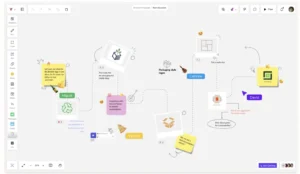
Vani’s impressive features create a “sky’s the limit!” collaborative environment for your team.
Then, there’s the real VIP— Catchups, which bring your team as close as they can get to creating together in person. Everybody can see each other, talk, create, and meet without losing context or having to switch screens. Say goodbye to boring Zoom meetings and screen-sharing. Catchups give your team the advantage of video but pile on the features that make meetings productive.
Review, plan, visualize, and play as a team! You’ll never have an unproductive meeting again. Well, we can’t promise that, but Vani makes it easy to collaborate in a way that makes “boring” a thing of the past.

Do you have a team? Then, it’s for you! Vani is perfect for any industry and its features are versatile for any business size. Marketing and Product Management departments love Vani. Small teams can get started with Vani for free! It’s incredibly affordable for growing agencies, too, at only $4/month when you pay annually. That’s such a great investment for a tool that will boost team collaboration like nobody’s business!
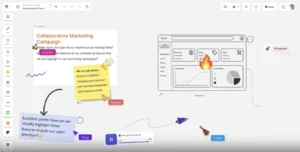
Zoho has done it again; this time, they’ve raised the bar with Vani. If you’re ready to boost your productivity and stay ahead of the curve, it’s time to get on board with Vani by Zoho. This isn’t just a product; it’s a revolution in how your team hits goals in real time.
Don’t just take our word for it—try it for yourself!
Ready to Optimize Daily Operations? Book a free consultation with us today.